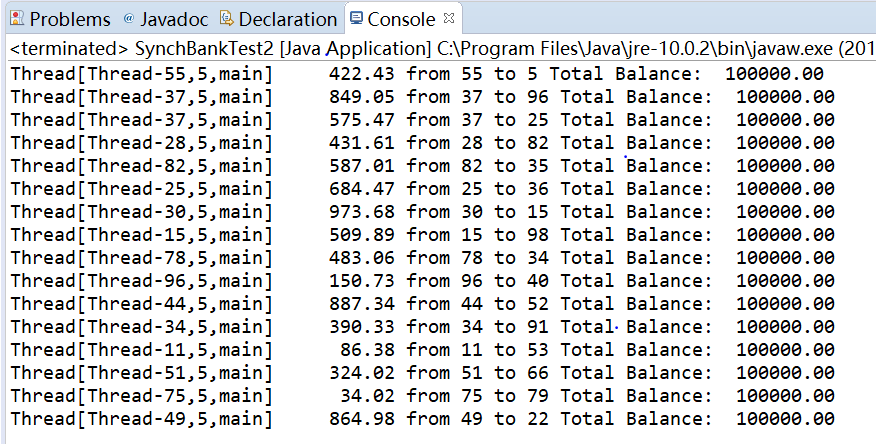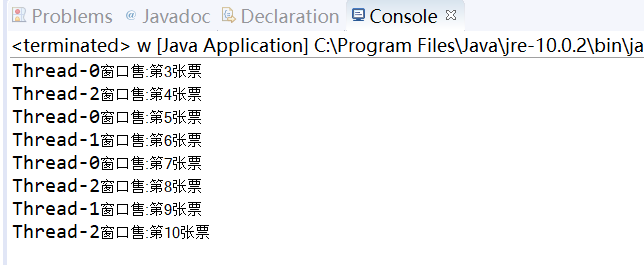| 项目 |
内容 |
| 这个作业属于哪个课程 |
https://www.cnblogs.com/nwnu-daizh |
| 这个作业的要求在哪里 |
https://www.cnblogs.com/nwnu-daizh/p/12073034.html |
|
作业学习目标 |
(1) 理解和掌握线程的优先级属性及调度方法; (2) 掌握线程同步的概念及实现技术; (3) Java线程综合编程练习
|
第一部分:总结线程同步技术
public synchronized void mutiThreadAccess();
只要把多个线程对类需要被同步的资源的操作放到mutiThreadAccess()方法中,就能保证这个方法在同一时刻只能被同一个线程访问,从而保证了多线程访问的安全性。然而,当一个方法的方法体规模非常大时,把该方法声明为synchronized会大大影响程序的执行效率。为了提高程序的效率,Java提供了synchronized块。
2.synchronized块
synchronized块既可以把任意的代码段声明为synchronized,也可以指定上锁的对象。其用法如下:
synchronized(syncObject){ //访问synchObject的代码 }
package javatest; import java.util.concurrent.locks.Lock; import java.util.concurrent.locks.ReentrantLock; public class LockTest { public static void main(String[] args)throws InterruptedException { // TODO Auto-generated method stub final Lock lock=new ReentrantLock(); lock.lock(); Thread t1=new Thread(new Runnable() { public void run() { try { lock.lockInterruptibly(); } catch(InterruptedException e) { System.out.println("interrupted"); } } }); t1.start(); t1.interrupt(); Thread.sleep(1); } }
如果把lock.lockInterruptibly()替换为lock.lock(),编译器将会提示lock.lock()catch代码块无效,这是因为lock.lock()不会抛出异常,由此可见lock()方法会忽略interrupt()引发的异常。
第二部分:实验总结
实验1:测试程序并进行代码注释。
测试程序1:
l 在Elipse环境下调试教材651页程序14-7,结合程序运行结果理解程序;
l 掌握利用锁对象和条件对象实现的多线程同步技术。
程序源代码为:
synch
package synch; import java.util.*; import java.util.concurrent.locks.*; /** * A bank with a number of bank accounts that uses locks for serializing access. * @version 1.30 2004-08-01 * @author Cay Horstmann */ public class Bank { private final double[] accounts; private Lock bankLock;//加锁 private Condition sufficientFunds;//有效条件 /** * Constructs the bank. * @param n the number of accounts * @param initialBalance the initial balance for each account */ public Bank(int n, double initialBalance) { accounts = new double[n]; Arrays.fill(accounts, initialBalance); bankLock = new ReentrantLock(); sufficientFunds = bankLock.newCondition(); } /** * Transfers money from one account to another. * @param from the account to transfer from * @param to the account to transfer to * @param amount the amount to transfer */ public void transfer(int from, int to, double amount) throws InterruptedException { bankLock.lock();//调用锁 try { while (accounts[from] < amount)//当 账户总余额大于转出金额 sufficientFunds.await();//调用await将该线程放入等待集中 System.out.print(Thread.currentThread()); accounts[from] -= amount; System.out.printf(" %10.2f from %d to %d", amount, from, to); accounts[to] += amount; System.out.printf(" Total Balance: %10.2f%n", getTotalBalance()); sufficientFunds.signalAll();//调用signalAll解除等待集中的所有线程的阻塞状态 } finally { bankLock.unlock();//解锁 } } /** * Gets the sum of all account balances. * @return the total balance */ public double getTotalBalance() { bankLock.lock(); try { double sum = 0; for (double a : accounts) sum += a; return sum; } finally { bankLock.unlock(); } } /** * Gets the number of accounts in the bank. * @return the number of accounts */ public int size() { return accounts.length; } }
package synch; /** * This program shows how multiple threads can safely access a data structure. * @version 1.31 2015-06-21 * @author Cay Horstmann */ public class SynchBankTest { public static final int NACCOUNTS = 100; public static final double INITIAL_BALANCE = 1000; public static final double MAX_AMOUNT = 1000; public static final int DELAY = 10; public static void main(String[] args) { Bank bank = new Bank(NACCOUNTS, INITIAL_BALANCE); for (int i = 0; i < NACCOUNTS; i++) { int fromAccount = i; Runnable r = () -> { try { while (true) { int toAccount = (int) (bank.size() * Math.random()); double amount = MAX_AMOUNT * Math.random(); bank.transfer(fromAccount, toAccount, amount); Thread.sleep((int) (DELAY * Math.random()));//调用sleep,随机 } } catch (InterruptedException e)//抛出异常 { } }; Thread t = new Thread(r);//建立Thread类对象 t.start();//启动线程 } } }
实验输出结果截图为:
测试程序2:
l 在Elipse环境下调试教材655页程序14-8,结合程序运行结果理解程序;
l 掌握synchronized在多线程同步中的应用。
程序源代码为:
package synch2; import java.util.*; /** * A bank with a number of bank accounts that uses synchronization primitives. * @version 1.30 2004-08-01 * @author Cay Horstmann */ public class Bank { private final double[] accounts; /** * Constructs the bank. * @param n the number of accounts * @param initialBalance the initial balance for each account */ public Bank(int n, double initialBalance) { accounts = new double[n]; Arrays.fill(accounts, initialBalance); } /** * Transfers money from one account to another. * @param from the account to transfer from * @param to the account to transfer to * @param amount the amount to transfer */ public synchronized void transfer(int from, int to, double amount) throws InterruptedException { while (accounts[from] < amount) wait();//线程进入等待状态直到被通知 System.out.print(Thread.currentThread()); accounts[from] -= amount;//输出额 System.out.printf(" %10.2f from %d to %d", amount, from, to); accounts[to] += amount;//输入额 System.out.printf(" Total Balance: %10.2f%n", getTotalBalance()); notifyAll();//解除调用wait方法的线程的阻塞状态 } /** * Gets the sum of all account balances. * @return the total balance */ public synchronized double getTotalBalance() { double sum = 0; for (double a : accounts) sum += a; return sum; } /** * Gets the number of accounts in the bank. * @return the number of accounts */ public int size() { return accounts.length; } }
package synch2; /** * This program shows how multiple threads can safely access a data structure, * using synchronized methods. * @version 1.31 2015-06-21 * @author Cay Horstmann */ public class SynchBankTest2 { public static final int NACCOUNTS = 100; public static final double INITIAL_BALANCE = 1000; public static final double MAX_AMOUNT = 1000; public static final int DELAY = 10; public static void main(String[] args) { Bank bank = new Bank(NACCOUNTS, INITIAL_BALANCE); for (int i = 0; i < NACCOUNTS; i++) { int fromAccount = i; Runnable r = () -> { try { while (true) { int toAccount = (int) (bank.size() * Math.random()); double amount = MAX_AMOUNT * Math.random(); bank.transfer(fromAccount, toAccount, amount); Thread.sleep((int) (DELAY * Math.random())); } } catch (InterruptedException e) { } };//排队等待/阻塞 Thread t = new Thread(r);//新建线程 t.start();//启动线程 } } }
实验输出结果截图为:
测试程序3:
l 在Elipse环境下运行以下程序,结合程序运行结果分析程序存在问题;
尝试解决下列程序中的问题
class Cbank
{
private static int s=2000;
public static void sub(int m)
{
int temp=s;
temp=temp-m;
try {
Thread.sleep((int)(1000*Math.random()));
}
catch (InterruptedException e) { }
s=temp;
System.out.println("s="+s);
}
}
class Customer extends Thread
{
public void run()
{
for( int i=1; i<=4; i++)
Cbank.sub(100);
}
}
public class Thread3
{
public static void main(String args[])
{
Customer customer1 = new Customer();
Customer customer2 = new Customer();
customer1.start();
customer2.start();
}
}
实验代码为:
package wf; class Cbank { private static int s=2000; public static void sub(int m) { int temp=s; temp=temp-m; try { Thread.sleep((int)(1000*Math.random())); } catch (InterruptedException e) {
} s=temp; System.out.println("s="+s); } }
class Customer extends Thread { public void run() { for( int i=1; i<=4; i++) Cbank.sub(100); } } public class Thread3 { public static void main(String args[]) { Customer customer1 = new Customer(); Customer customer2 = new Customer(); customer1.start(); customer2.start(); } }
实验输出结果截图为:
程序修改代码后为:
package wf; class Cbank { private static int s=2000; public synchronized static void sub(int m) { int temp=s; temp=temp-m; try { Thread.sleep((int)(1000*Math.random())); } catch (InterruptedException e) { } s=temp; System.out.println("s="+s); } } class Customer extends Thread { public void run() { for( int i=1; i<=4; i++) Cbank.sub(100); } } public class Thread3 { public static void main(String args[]) { Customer customer1 = new Customer(); Customer customer2 = new Customer(); customer1.start(); customer2.start(); } }
实验输出结果截图为:
实验2 编程练习
利用多线程及同步方法,编写一个程序模拟火车票售票系统,共3个窗口,卖10张票,程序输出结果类似(程序输出不唯一,可以是其他类似结果)。
Thread-0窗口售:第1张票
Thread-0窗口售:第2张票
Thread-1窗口售:第3张票
Thread-2窗口售:第4张票
Thread-2窗口售:第5张票
Thread-1窗口售:第6张票
Thread-0窗口售:第7张票
Thread-2窗口售:第8张票
Thread-1窗口售:第9张票
Thread-0窗口售:第10张票
实验代码为:
package wf; import java.nio.charset.MalformedInputException; public class w { public static void main(String[] args) { Mythread mythread= new Mythread(); Thread t1 = new Thread(mythread); Thread t2 = new Thread(mythread); Thread t3 = new Thread(mythread); t1.start(); t2.start(); t3.start(); } } class Mythread implements Runnable{ int t=1; boolean flag=true; public void run() { while(flag) { try { Thread.sleep(500); } catch (InterruptedException e) { e.printStackTrace(); } synchronized (this) { if(t<=10){ System.out.println(Thread.currentThread().getName()+"窗口售:第"+t+"张票"); t++; } if(t>10){ flag=false; } } } } }
实验输出结果截图为:
第三部分 实验总结
这周是我们上的最后一节java课,也预示着一学期的Java课结束了,但是课堂上的我们还是没有丝毫松懈。这周我们主要还是学习了有关线程方面更加重要的知识。有关线程并发执行中可能出现的各种问题,比如当有两个或者两个以上的线程共享某个对象,每个线程都调用了改变该对象类状态的方法时会初心什么情况。就这个问题,老师给我们展开了详细的解说。正如老师说的“这些问题都是我们在使用计算机的过程中真实会发生的情况”所以掌握这些知识是极其重要的。对于我个人而言,我觉得这节课掌握的相对较好的知识点是有关线程的状态这个方面,而且在这些知识点上老师通过图表讲解的非常详细。我以后也会继续好好学习Java相关知识。





